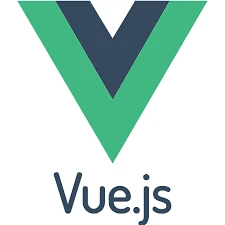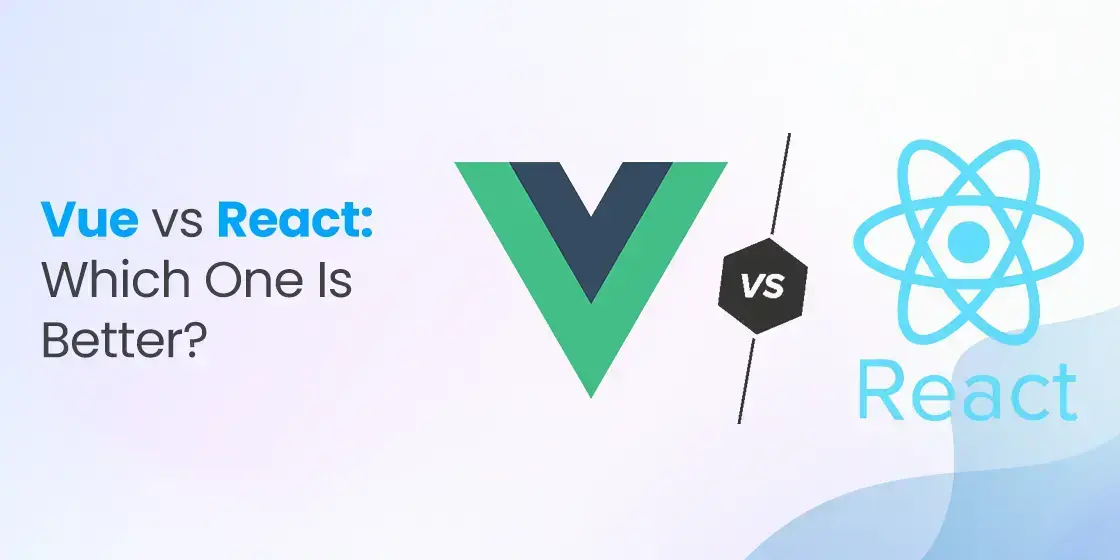Table of Content
Know the Key Differences Between Vue and React JavaScript Frameworks
Starting your career as a frontend developer, you need to learn various languages that provide help in creating interfaces. Though there are plenty of such languages available in the market, but today, we will talk about those that are used most by the developers. The name of Vue vs React always comes first to this debate, because both of these languages are used extensively by the developers to create interactive website/app interfaces.
Learning Vue and React is therefore considered important for those who want to offer quality software development services. But, before starting practicing their code, you need to know the differences between them. You need to know how both of these frontend languages work and what type of benefits they give to the users. Knowing this distinction not only brings clarity in your mind, but also helps you to decide the perfect pick for your project. This is certainly an important point, because lot of beginners often start to learn these languages without knowing their basics.
In this article, we will settle the debate between Vue vs React comparison. We will let you know all the details about both of these languages. So, without wasting much time, let’s start from the basics understanding what these languages are and why they have become increasingly popular among the frontend developers.
What is Vue?

Vue.js is a widely recognized open-source framework based on JavaScript, primarily designed for creating dynamic and interactive user interfaces. Its flexibility and simplicity have made it a go-to choice for developers working on modern web applications. With its component-based architecture, Vue.js allows developers to build reusable and modular UI elements, making the development process more streamlined and efficient.
One of the primary use cases of Vue.js is in the development of single-page applications (SPAs). These applications provide a seamless user experience by dynamically loading content without requiring a full-page reload. Vue.js excels in this domain by offering a reactive data-binding system and a virtual DOM, which together ensure high performance and smooth user interactions. This capability makes it particularly appealing for projects that demand responsiveness and scalability.
Additionally, Vue.js is supported by an active community and a rich ecosystem of tools and libraries. These resources simplify tasks such as state management, routing, and testing, further enhancing productivity. Its comprehensive documentation and approachable learning curve make it accessible to both novice and experienced developers, solidifying its position as a preferred framework for building modern web applications.
What is React?

React.js is an open-source JavaScript library developed and maintained by Meta (formerly Facebook), designed for building user interfaces, particularly for single-page applications (SPAs). It focuses on creating reusable UI components, allowing developers to build complex interfaces efficiently by breaking them into smaller, manageable pieces. React utilizes a component-based architecture, where each component manages its own state and renders independently, enabling a modular and scalable development approach.
A standout feature of React.js is its Virtual DOM (Document Object Model), which optimizes the rendering process. Instead of directly updating the real DOM with every state change, React first updates a lightweight in-memory representation of the DOM (the Virtual DOM). It then calculates the minimal set of changes required and efficiently applies them to the real DOM. This approach significantly improves performance and responsiveness, especially in applications with frequent UI updates.
React.js is further enhanced by a vibrant ecosystem and strong community support. Libraries like React Router for navigation and Redux or Context API for state management complement React’s core functionality. Moreover, tools such as Next.js facilitate server-side rendering and static site generation, expanding React’s capabilities beyond client-side rendering. With comprehensive documentation, and widespread adoption by major tech companies, React.js remains one of the most popular and versatile tools for building modern web applications.
Why Frontend Developers Love Vue and React?
Vue and React have become increasingly popular among frontend developers due to their efficient approaches to building dynamic and interactive user interfaces. Both frameworks address key challenges in modern web development, such as managing complex state, optimizing rendering performance, and improving developer productivity. React, developed by Facebook, introduced the concept of a virtual DOM, which significantly enhances rendering efficiency by updating only the necessary components in the user interface.
Another reason for their widespread adoption is the strong ecosystems and community support surrounding. React boasts a vast library of third-party tools, making it highly adaptable for projects of varying sizes and complexities. Vue, while having a smaller community compared to React, still provides an extensive set of tools like Vue CLI and Vuex for state management, which simplify the development process. Both web development frameworks also benefit from strong documentation, ensuring continuous improvement and adaptability to industry trends.
The flexibility and scalability of Vue and React also make them suitable for a wide range of applications, from small projects to large-scale enterprise systems. React’s component-based architecture allows developers to build reusable UI components that can be easily maintained and scaled across different projects. Vue’s progressive framework design enables developers to incrementally adopt its features, starting with simple UI enhancements and scaling up to full single-page applications.
Benefits of Using React

React offers different types of benefits to the developers. It is largely popular due to offering reusable components, but that is not just the all about React. The language offers many other advantages besides this, so let’s take a look at them below.
Dynamic Development
React.js leverages JSX, a syntax extension for JavaScript that allows developers to write HTML-like code directly within JavaScript files. JSX simplifies the creation of user interface components by enabling a clear and readable syntax for defining the structure and appearance of UI elements. With JSX, developers can seamlessly integrate HTML tags with JavaScript logic.
React.js also excels at efficiently handling HTML strings and supporting machine-readable code, which are essential for building modern, dynamic web applications. Instead of directly interacting with the real DOM, React uses a Virtual DOM to optimize updates and minimize rendering overhead.
Faster Performance
React.js utilizes the Virtual DOM (Document Object Model), an in-memory representation of the actual DOM, to optimize the rendering process and improve web application performance. Traditionally, updating the real DOM is a resource-intensive operation, as every change triggers re-rendering and recalculations across the web page.
The Virtual DOM in React works seamlessly with HTML, XML, or XHTML structures, ensuring compatibility with different document formats and markup languages. By abstracting direct interactions with the real DOM, React minimizes costly browser operations and optimizes rendering performance across devices and browsers.
Reusable Components
React.js is designed around a component-based architecture, where each component represents a self-contained, reusable piece of the user interface with its own logic, state, and controls. This modular design allows developers to break down a complex user interface into smaller, more manageable parts, each responsible for rendering a specific section of the UI.
In addition to standalone components, React supports the creation of nested components, where smaller components are embedded within larger parent components. This nesting structure allows developers to build intricate and hierarchical user interfaces while keeping the codebase organized and modular.
Extensive Library
One of the key advantages of React is its extensive ecosystem of libraries and tools, which significantly enhances the cross platform development process and simplifies common tasks. React itself focuses on building user interfaces, but it integrates seamlessly with a wide range of third-party libraries to handle additional functionalities such as state management, routing, and API integration.
Additionally, React’s library ecosystem supports various aspects of application development, including testing, styling, and server-side rendering. Testing libraries like Jest and React Testing Library enable developers to write comprehensive unit and integration tests, ensuring the reliability and stability of their applications.
SEO Friendly
React.js is often considered SEO-friendly because it can be optimized to ensure that web applications built with it rank well in search engine results. Typically, JavaScript-heavy single-page applications (SPAs) face challenges with SEO because search engine crawlers may struggle to index content that is dynamically rendered client-side.
Moreover, React’s ability to work with tools like Next.js further enhances its SEO capabilities. Next.js, a popular framework that provides automatic server-side rendering and static site generation. This results in faster page load times and ensures that search engines receive fully rendered HTML, making it easier for them to index and rank the content.
Benefits of Using Vue

Many frontend developers also use Vue because it provides plethora of benefits. If you do not know much about these advantages, take a look at the points given below. It will let you know why developers love to use Vue to create different types of interfaces.
Simple Usage
Vue.js utilizes a single-file component-based architecture, which consolidates all the necessary code for each component i.e. HTML, CSS, and JavaScript into a single file. This approach enhances the organization and maintainability of the code, as all the related elements of a component are contained within one place.
Moreover, this single-file component architecture makes testing more manageable and streamlined. Since each component is self-contained, developers can easily isolate and test individual parts of the application. This improves the overall testing process, allowing for focused unit testing of specific components without the need to worry about external dependencies.
Easy to Adapt
Vue.js enhances the development process by offering additional markup to the standard HTML code, which simplifies and accelerates the creation of dynamic and interactive web applications. Through its use of templates, Vue allows developers to extend HTML with special directives. This built-in functionality reduces the need for developers to manually write extensive code from scratch.
In contrast to others coding languages, which require developers to manually write extensive JavaScript code to achieve similar functionality, Vue offers these additional features out of the box. This approach not only makes it easier to create interactive and responsive user interfaces but also reduces the amount of boilerplate code that developers need to maintain.
Lightweight
Vue.js is often referred to as a lightweight framework due to its small file size and minimal overhead, which makes it an ideal choice for projects. Compared to other front-end frameworks, Vue’s core library is relatively compact, allowing developers to implement the essential features of a web application without the need for extensive additional dependencies.
In addition to its small file size, Vue’s simplicity and flexibility contribute to its lightweight reputation. The framework provides developers with a basic set of tools that are sufficient for most use cases, but it does not enforce rigid patterns or structures, allowing for a more lightweight and customizable development experience.
Easy to Integrate
Vue.js is often praised for its ease of integration with other frameworks and existing projects, primarily due to its flexible and modular design. Unlike some other front-end frameworks that require a complete overhaul of the application structure, Vue can be introduced incrementally. This means developers can integrate Vue into a specific part of a web application without having to rewrite the entire codebase.
Additionally, Vue’s simple and clear API makes it easy to work alongside other technologies, as it does not impose strict conventions or complex configurations. Vue is designed to be progressively adoptable, meaning developers can use it to enhance an existing app step by step, such as by adding interactive components or replacing parts of the UI with Vue components.
Vue vs React: Which One You Should Choose?
Vue, React, and other JavaScript frameworks each offer unique advantages that make them highly effective for specific use cases. React excels in building complex and dynamic user interfaces, thanks to its component-based architecture and efficient virtual DOM. Vue, on the other hand, is known for its simplicity and ease of integration, making it ideal for developers who want to gradually enhance their applications without a steep learning curve.
When choosing between frameworks, the most effective approach is to carefully evaluate your project’s use case and align it with the strengths and weaknesses of each option. Start by identifying the key features your application requires—such as scalability, ease of use, performance, or community support—and consider how each framework meets these needs. By outlining your specific goals and constraints, you can make a more informed decision in terms of picking the right technology.
Frequently Asked Questions
| What is Vue.js? Vue.js is a progressive, open-source JavaScript framework used for building user interfaces and single-page applications. It features a component-based architecture, offering simplicity and flexibility for developers to create dynamic, responsive web apps. |
| What is React? React is an open-source JavaScript library developed for building website/app frontend. It uses a component-based architecture and a virtual DOM to efficiently render and update dynamic web pages. |
| Why Vue and React are popular among the developers? Vue and React are popular among developers due to their flexibility and component-based architecture. Both frameworks offer robust ecosystems, efficient performance, and strong community support, making them ideal choices for modern web development. |
Final Words
That sums up our entire article in which we have discussed some core differences between Vue and React frameworks. As a frontend developer, you need to learn both of these languages as they are highly demanded in the industry. You also need to know the differences between these two technologies, as that allows you to pick the right framework for particular tasks or projects. So make sure to read this article properly, as it will help you to understand the differences and utility of both frameworks.

Empower your digital journey with StruqtIO - Your dedicated partner for cutting-edge custom software development, innovation, and digital transformative solutions. Harness the power of technology to elevate your business and redefine your digital landscape today.


